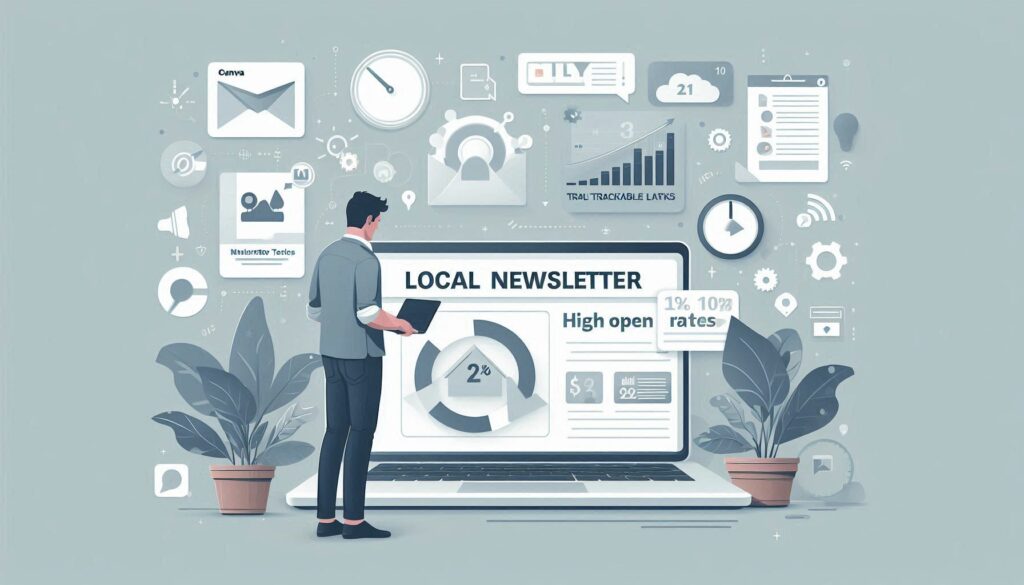If you run a small business, you already know that the most powerful marketing doesn’t come from billboards or paid ads. It comes from trust. And one of the most trusted sources of information isn’t a social media feed or a search engine result. It’s the local newsletter. Yes, you can grow your local business with newsletters. That weekly email from the chamber of commerce, the neighborhood digest, or the hyper-local Substack about farmers’ markets and school events- these are where your customers go to stay connected. And that’s exactly where you should be. So, how can you grow your local business with newsletters? Here’s a proven, low-cost approach that builds real relationships and drives measurable results.
The Power of Local Newsletters
In an age of algorithm fatigue and ad overload, local newsletters stand out for one simple reason- people still read them. According to Beehiiv’s 2024 email marketing report, niche newsletters consistently achieve open rates of 35–40%, compared to just 2–5% for most social media posts. More importantly, these readers aren’t just skimming. They’re engaged, local, and ready to act.
For small business owners, this means one thing: a direct line to customers who already care about your community.
When your business is featured in a trusted local newsletter, you’re not interrupting someone’s scroll. You’re showing up in a place they’ve chosen to be- a place where your message feels like a recommendation from a neighbor, not an ad.
How Local Newsletters Drive Real Growth
Being featured in a local newsletter can do more than boost awareness. It can:
- Increase foot traffic. A well-timed offer like “Show this email for 15% off” can bring dozens of new customers through your door in a single weekend.
- Drive online bookings and sales. Include a direct link to your website or booking page, and watch inquiries roll in without spending a dollar on ads.
- Spark word-of-mouth. Readers forward newsletters. One feature can reach two or three times the original subscriber list.
How to Get Featured in a Local Newspaper: A Step-by-Step Guide
Getting into a local newsletter isn’t about buying an ad. It’s about offering value first. Here’s how to do it right.
Step 1: Find the Right Newsletters
Not all newsletters are equal. Look for ones that:
- Serve your exact community (your city, neighborhood, or customer niche)
- Have 500–5,000 engaged subscribers
- Boast open rates above 40%
Start your search on platforms like Substack, Beehiiv, or Ghost. You can also check your local chamber of commerce, business association emails, or even ask fellow shop owners which newsletters they read.
Step 2: Pitch with Value, Not Sales
Editors are protective of their audience, so focus on leading with generosity.
Use this email template:
Subject: Free tip to help [Town Name] businesses thrive
Hi [Editor’s Name],
I’m [Your Name] from [Your Business]. I’ve been a reader of [Newsletter Name] for months, and your recent coverage of [specific recent topic] was especially insightful.
I’d like to contribute a short, helpful piece titled “3 Simple Ways Local Shops Can Get More Customers This Season.” There is no sales pitch—just practical advice your readers can immediately put to use.
If it aligns with your publication’s style, I can also include a small thank-you offer for readers, such as 10% off for the first 15 who mention the newsletter.
Please let me know if you’d like to review a draft.
Best,
[Your Name]
[Phone] | [Website]
Personalization is essential. Reference a recent issue to show you’re genuinely engaged as a reader, not simply promoting your business.
Step 3: Craft Content That Converts
Once your contribution is accepted, keep your content short, clear, and action-oriented. Aim for 250–400 words, and structure it as follows:
A relatable hook: “Want more customers walking through your door this weekend?”
Two or three actionable tips: “Update your Google hours, share a weekend special, or reply for a free review of your online presence.”
A compelling offer: “Show this email in-store for 15% off—valid this week only.”
A P.S. that creates urgency: “P.S. This offer ends Sunday—don’t miss out.”
Include one high-quality photo—whether it’s your storefront, your team, or a featured product. Keep your paragraphs brief, use bold text for key phrases, and ensure the entire piece is mobile-friendly.
Designing Offers That Work
The most effective offers are specific, time-bound, and easy for customers to redeem. Here are four proven types:
Discounts: “15% off when you show this email”
Free add-ons: “Free dessert with any entrée”
Exclusive access: “First 10 customers get a free 15-minute consult”
Bundled deals: “Coffee + pastry for $5”
Tracking Results and Building Momentum
Don’t leave your success to guesswork. Measure it carefully. Here’s a quick guide:
In-store: Ask every customer, “How did you hear about us?” and train your staff to record any “newsletter” responses.
Online: Use a trackable link (e.g., yourwebsite.com/offer?utm_source=westenddigest) created with Bitly or Google’s Campaign URL Builder.
Follow up: After your feature goes live, send the editor a thank-you email and share your results. This builds goodwill and increases your chances of future features.
Aim to appear in the same newsletter every 6–8 weeks so you gradually become a familiar and trusted name.
Tools to Streamline the Process
You don’t need complex software to manage this. These free tools are more than enough:
- Canva, to create simple, branded visuals
- Bitly, to shorten and track links
- Google Sheets to record redemptions and results
- Mailchimp to send follow-up emails
The Long-Term Advantage of Local Newsletters for Your Business
Consistency transforms one-time features into lasting recognition. After three or four appearances, customers will begin to say, “I see you in the newsletter all the time.” At that point, you become the default choice in your category.
Eventually, editors may even start reaching out to you for content, which is when you know your strategy is truly working.
Your 7-Day Action Plan
1st Day: Identify three local newsletters that reach your ideal customers.
2nd Day: Read two recent issues and note their tone, topics, and style.
3rd Day: Draft your pitch email with a clear, specific value offer.
4th Day: Send your personalized pitch.
5th Day: Prepare your offer, photo, and concise content.
6th Day: Follow up if you haven’t received a reply.
7th Day: Celebrate your first feature, and track the results.
Grow your local business with newsletters. This is not about going viral. It’s about showing up consistently where your customers already place their trust. Start with one newsletter, one offer, and one measurable result, and then watch your business and reputation grow.


